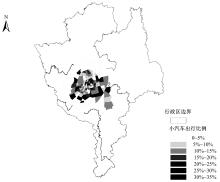吉林大学学报(工学版) ›› 2023, Vol. 53 ›› Issue (7): 1994-2000.doi: 10.13229/j.cnki.jdxbgxb.20210958
• 交通运输工程·土木工程 • 上一篇
考虑空间自相关的建成环境对通勤方式选择的影响
- 1.南京林业大学 汽车与交通工程学院,南京 210037
2.北京交通大学 综合交通运输大数据应用技术交通运输行业重点实验室,北京 100044
3.兰州交通大学 交通运输学院,兰州 730070
Impacts of built environment on commuting mode choice considering spatial autocorrelation
Chao-ying YIN1( ),Ying LU1,Chun-fu SHAO2(
),Ying LU1,Chun-fu SHAO2( ),Jian-xiao MA1,De-jie XU3
),Jian-xiao MA1,De-jie XU3
- 1.College of Automobile and Traffic Engineering,Nanjing Forestry University,Nanjing 210037,China
2.Key Laboratory of Transport Industry of Big Data Application Technologies for Comprehensive Transport,Beijing Jiaotong University,Beijing 100044,China
3.School of Traffic and Transportation,Lanzhou Jiaotong University,Lanzhou 730070,China
摘要:
为探究城市空间结构对居民通勤行为的影响,考虑居民通勤出行行为在相邻交通小区间具有相似性这一特性,建立能够捕捉通勤行为空间自相关的层次Bayesian模型,分析交通小区尺度建成环境影响下居民个体通勤方式选择行为决策过程。研究结果表明:居民通勤方式选择行为在交通小区间的空间自相关是显著存在的;采用质点空间距离矩阵的模型拟合效果最优;除个体尺度社会经济特征外,交通小区尺度建成环境特征依然是影响居民通勤方式选择的重要因素;其中,土地利用混合度、公共交通站点密度及交叉口密度均与居民小汽车通勤方式选择有显著的负相关关系,表明通过适当增加居民居住交通小区内的公共交通站点数量、提高交通小区土地利用混合度和优化街区路网设计可有效降低居民使用小汽车通勤的概率。
中图分类号:
- U491
| 1 | 吕雄鹰, 潘海啸. 低碳出行导向下新城居住区建成环境优化研究——以上海市松江新城为例[J]. 住宅科技, 2021, 41(5): 60-66, 72. |
| Lv Xiong-ying, Pan Hai-xiao. Study on the built environment optimization of new city residential area under the guidance of low carbon travel—an investigation study of songjiang new city[J]. Housing Science, 2021, 41(5): 60-66, 72. | |
| 2 | Zhao P. The impact of the built environment on individual workers' commuting behavior in Beijing[J]. International Journal of Sustainable Transportation, 2013, 7(5): 389-415. |
| 3 | 尹超英,邵春福,王晓全,等. 考虑空间异质性的建成环境对通勤方式选择的影响[J].吉林大学学报:工学版,2020,50(2):543-548. |
| Yin Chao-ying, Shao Chun-fu, Wang Xiao-quan,et al. Influence of built environment on commuting mode choice considering spatial heterogeneity[J]. Journal of Jilin University(Engineering and Technology Edition), 2020, 50(2): 543-548. | |
| 4 | Christiansen P, Engebrersen Ø, Feaenley N,et al. Parking facilities and the built environment: Impacts on travel behaviour[J]. Transportation Research Part A: Policy and Practice, 2017, 95: 198-206. |
| 5 | 尹超英,邵春福,王晓全. 考虑停车可用性的建成环境对小汽车通勤出行的影响[J]. 吉林大学学报:工学版, 2019, 49(3): 714-719. |
| Yin Chao-Ying, Shao Chun-Fu, Wang Xiao-Quan. Influence of urban built environment on car commuting considering parking availability[J]. Journal of Jilin University(Engineering and Technology Edition), 2019, 49(3): 714-719. | |
| 6 | 李根, 翟伟, 朱兴贝, 等. 侧向碰撞风险对交织区汇合行为的影响[J].交通运输系统工程与信息, 2021, 21(4): 204-210. |
| Li Gen, Zhai Wei, Zhu Xing-Bei,et al. Influence of lateral collision risk on merging behavior of weaving area[J]. Journal of Transportation Systems Engineering and Information Technology, 2021, 21(4): 204-210. | |
| 7 | Wang X, Yin C, Zhang J, et al. Nonlinear effects of residential and workplace built environment on car dependence[J]. Journal of Transport Geography, 2021, 96: No.103207. |
| 8 | Hong J, Shen Q, Zhang L. How do built-environment factors affect travel behavior? a spatial analysis at different geographic scales[J]. Transportation, 2014, 41(3): 419-440. |
| 9 | 尹超英, 邵春福, 王聘玺, 等. 基于多层模型的城市建成环境对通勤行为的影响[J]. 交通运输系统工程与信息, 2018, 18(2):122-127. |
| Yin Chao-ying, Shao Chun-fu, Wang Pin-xi,et al. Impacts of built environment on commuting behavior based on a multilevel modeling approach[J]. Journal of Transportation Systems Engineering and Information Technology, 2018, 18(2): 122-127. | |
| 10 | 王雪松,袁景辉. 城郊公路路网特征交通安全影响研究[J]. 中国公路学报, 2017, 30(4): 106-114. |
| Wang Xue-song, Yuan Jing-hui. Safety impacts study of roadway network features on suburban highways[J]. China Journal of Highway and Transport, 2017, 30(4): 106-114. | |
| 11 | 杨励雅,王振波. 城市社区建成环境对居民日常出行行为的影响分析[J].经济地理, 2019, 39(4): 101-108. |
| Yang Li-ya, Wang Zhen-bo. Impact of residential built environment on daily travel behavior[J]. Economic Geography, 2019, 39(4): 101-108. | |
| 12 | Van A V, Witlox F. Commuting trips within tours: how is commuting related to land use?[J]. Transportation, 2011, 38(3): 465-486. |
| 13 | Wang X, Shao C, Yin C,et al. Built environment, life events and commuting mode shift: Focus on gender differences[J]. Transportation Research Part D: Transport and Environment, 2020, 88: No.10259. |
| 14 | Ding C, Wang D, Liu C, et al. Exploring the influence of built environment on travel mode choice considering the mediating effects of car ownership and travel distance[J]. Transportation Research Part A: Policy and Practice, 2017, 100: 65-80. |
| [1] | 马壮林,崔姗姗,胡大伟,王晋. 限行政策下传统小汽车出行者出行方式选择[J]. 吉林大学学报(工学版), 2023, 53(7): 1981-1993. |
| [2] | 潘恒彦,王永岗,李德林,陈俊先,宋杰,杨钰泉. 基于交通冲突的长纵坡路段追尾风险评估及预测[J]. 吉林大学学报(工学版), 2023, 53(5): 1355-1363. |
| [3] | 宋灿灿,荆迪菲,谢俊峰,康可心. 设置广告牌的高速公路平曲线路段驾驶行为分析[J]. 吉林大学学报(工学版), 2023, 53(5): 1345-1354. |
| [4] | 卢凯,徐广辉,叶志宏,林永杰. 考虑清空时间的双向队首绿波协调控制数解算法[J]. 吉林大学学报(工学版), 2023, 53(2): 421-429. |
| [5] | 张鑫,张卫华. 快速路合流区主线不同交通状态下的安全性分析[J]. 吉林大学学报(工学版), 2022, 52(6): 1308-1314. |
| [6] | 尹超英,邵春福,黄兆国,王晓全,王晟由. 基于梯度提升决策树的多尺度建成环境对小汽车拥有的影响[J]. 吉林大学学报(工学版), 2022, 52(3): 572-577. |
| [7] | 曲大义,赵梓旭,贾彦峰,王韬,刘琼辉. 基于Lennard-Jones势的车辆跟驰动力学特性及模型[J]. 吉林大学学报(工学版), 2022, 52(11): 2549-2557. |
| [8] | 董春娇,董黛悦,诸葛承祥,甄理. 电动自行车出行特性及骑行决策行为建模[J]. 吉林大学学报(工学版), 2022, 52(11): 2618-2625. |
| [9] | 吴静娴,申华鹏,韩印,杨敏. 考虑城市建成环境非线性作用的通勤时间模型[J]. 吉林大学学报(工学版), 2022, 52(11): 2568-2573. |
| [10] | 曲大义,黑凯先,郭海兵,贾彦峰,王韬. 车联网环境下车辆换道博弈行为及模型[J]. 吉林大学学报(工学版), 2022, 52(1): 101-109. |
| [11] | 张文会,伊静,刘委,于秋影,王连震. 基于MADYMO的大客车追尾碰撞事故乘员损伤机理[J]. 吉林大学学报(工学版), 2022, 52(1): 118-126. |
| [12] | 刘志伟,刘建荣,邓卫. 基于潜在类别的无人驾驶汽车选择行为[J]. 吉林大学学报(工学版), 2021, 51(4): 1261-1268. |
| [13] | 徐进,潘存书,符经厚,刘俊,王郸祁. 典型道路场景以及场景切换时的速度行为特性[J]. 吉林大学学报(工学版), 2021, 51(4): 1331-1341. |
| [14] | 查伟雄,蔡其燕,李剑,严利鑫. 边路车辆出入条件下城市干线信号协调相位差优化[J]. 吉林大学学报(工学版), 2021, 51(2): 565-574. |
| [15] | 尹超英,邵春福,王晓全,熊志华. 考虑空间异质性的建成环境对通勤方式选择的影响[J]. 吉林大学学报(工学版), 2020, 50(2): 543-548. |
|
||

